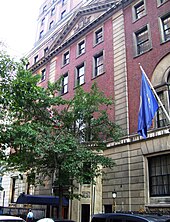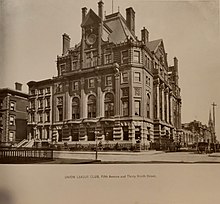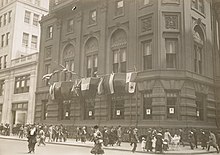Union League New York Art Exhibit January 1896the Journal New York Ny
Coordinates: twoscore°44′57″N 73°58′51″West / 40.749261°Northward 73.980839°W / 40.749261; -73.980839
 Outside of the clubhouse in 2018 | |
| Germination | 1863 |
|---|---|
| Type | Private social club |
| Tax ID no. | 13-1423100 |
| Location |
|
| Affiliations | Union League |
| Website | unionleagueclub.org |

The Union League Club is a individual social gild in New York City that was founded in 1863. Its fourth and electric current clubhouse is located at 38 E 37th Street on the corner of Park Artery, in the Murray Hill neighborhood of Manhattan. It was designed by Benjamin Wistar Morris and opened on February two, 1931.[1] The building was designated a New York City landmark on October 25, 2011.[2] The club is considered one of the most prestigious in New York Metropolis.[3]
Wedlock League clubs, which are legally separate but share similar histories and maintain reciprocal links with ane some other, are likewise located in Chicago and Philadelphia. Boosted Union League clubs were formerly located in Brooklyn, New York and New Oasis.
History [edit]
The club dates its founding from February half dozen, 1863, during the Civil War. Tensions were running high in New York Metropolis at the time, because much of the city'south governing form, as well as its big Irish immigrant population, bitterly opposed the state of war and were eager to accomplish some kind of accommodation with the Confederate States of America. Thus, pro-Marriage men chose to grade their own social club, with the twin goals of cultivating "a profound national devotion" and to "strengthen a love and respect for the Wedlock."
The Union League (also known as Loyal Leagues) was actually a political movement before it became a social organization. Its members raised coin both to support the United States Sanitary Committee, the forerunner of the American Red Cross, which cared for the Wedlock wounded following battles, and the Union cause generally.
The New York League was founded by four prominent professionals and intellectuals: Henry Whitney Bellows, Frederick Law Olmsted, George Templeton Strong, and Oliver Wolcott Gibbs. The men, all members of the U.s.a. Sanitary Commission, desired to strengthen the nation state and the national identity. They first aimed to recruit a coalition of moneyed professionals like themselves. Potent believed that the club would only thrive with a respectable catalogue of moneyed men. Olmsted particularly desired to recruit the new generation of young, wealthy men, and then that the society might teach them the obligations and duties of the upper class.[4]
The founders aimed to win the political governing aristocracy over to support of the Spousal relationship and abolitionism. They also believed that a centralized government was essential to their prosperity. The national government enforced contracts, tariffs, and an expanding infrastructure, all in the all-time interest of the professionals in the merchant, fiscal, and manufacturing classes, which in plough, benefited the population at large. These professionals also Developed an economic interest in the federal authorities, because as the state of war progressed, Union League ideas had their outcome and New York Urban center's elite bore a disproportional amount of the nation's debt. As they bought more and more war bonds, the holders had an increasing economic involvement in the success of the Wedlock, in addition to the convictions that led them to buy the bonds in the starting time identify.[4]

The gild held its start official coming together on March 20, 1863. At this get-go coming together, Robert B. Minturn, head of the nation's second largest shipping house, was elected president. Some of the elected vice presidents included William H. Aspinwall, Moses Taylor, and Alexander T. Stewart.[4]
It did not take long for the club's enemies to brand their displeasure felt with the new arrangement. On July 13, 1863, just five months afterwards the club's foundation and only days after receiving give-and-take of the twin Union victories at Gettysburg and at Vicksburg, the New York Draft Riots exploded correct in the lodge's backyard. The Union League Social club was high on the vandals' list of targets (right after the Colored Orphan Asylum), but some brave members kept them at bay past maintaining an armed vigil in the locked and barricaded clubhouse on East 17th Street, but off Union Square Park.

Bellamy salutes in 1917 at a Fifth Artery, New York anniversary reverse the Union League Club reviewing stand up during the recent "Wake Up, America" celebration where thousands marched in the procession
A few months after, the members decided to make an unmistakable gesture that they had not been intimidated. The club decided to recruit, train and equip a Colored infantry regiment for Union service. The 20th U.Southward. Colored Infantry was formed on Riker's Isle in February 1864. The side by side month, information technology marched from the Spousal relationship League Lodge, downwards Canal Street and over to the Hudson River piers to embark for duty in Louisiana. In spite of numerous threats, the members of the Union League Club marched with the men of the 20th, and saw them off. During World State of war I, the guild sponsored the 369th Infantry, the famed Harlem Hellfighters, which was allowable by William Hayward, a club member.
During Reconstruction, Spousal relationship Leagues were formed all across the Due south. They mobilized freedmen to register to vote. They discussed political issues, promoted civic projects, and mobilized workers opposed to segregationist white employers. Most branches were segregated just in that location were a few that were racially integrated. The leaders of the all-black units were by and large urban Blacks from the N, who had never been slaves. Foner (p 283) says "virtually every Blackness voter in the South had enrolled." Black League members were special targets of the Ku Klux Klan'southward violence and intimidation, so the Leagues organized informal armed defense units.
After the end of Reconstruction, the Union League Club of New York devoted itself to borough projects and clean government. Information technology and its members helped to constitute the Metropolitan Museum of Art,[5] and assisted in building the Statue of Freedom[6] and Grant's Tomb.

Previous clubhouses [edit]
The ULC'due south first clubhouse, built in 1863 was at 26 East 17th Street, facing Union Square. The second clubhouse was the Jerome Mansion, the childhood domicile of Winston Southward. Churchill's mother Jennie Jerome, at Madison Avenue and East 26th Street, facing Madison Square Park (1868).

3rd clubouse, seen in 1890
The order and so moved to Fifth Avenue and West 39th Street (1881); the building included decor designed by Frank Hill Smith, John La Farge, Augustus Saint-Gaudens, and Will Hicok Low.[7] [8] [9] The lodge remained there until the move to the nowadays building at 37th Street and Park Avenue. The property was purchased from J.P. Morgan II. Different many lodge buildings, the current clubhouse is purpose-built, rather than being a converted mansion or building constructed for another purpose.
Membership [edit]
The guild has e'er promoted clean government and public-spiritedness. Many of its early on members, notably cartoonist Thomas Nast, were instrumental in breaking "Boss" Tweed'south political organization.[1] (A futurity guild president, Elihu Root, served every bit i of Tweed'south defense force counsels.) Manhattan District Attorney and club member Charles S. Whitman used the privacy afforded past the club to secretly interview witnesses during his investigation of the case that sent NYPD Lt. Charles Becker to the electrical chair in 1915. Whitman was elected New York Governor as a issue.
In all, 15 U.Southward. Presidents have been members of the club.[10] Two presidents, Theodore Roosevelt and Chester A. Arthur, were members of the social club prior to inbound the White Firm and former presidents resident in New York, notably Ulysses S. Grant and Herbert Hoover, were agile members.
Theodore Roosevelt was blackballed when he first applied for membership in 1881, possibly considering his female parent, Martha Bulloch Roosevelt, was a well-known Confederate sympathizer. Following the sudden deaths of his married woman and mother in 1884, however, he was offered membership and accepted. After running on the Balderdash Moose Party ticket in 1912, Roosevelt was persona not grata at the gild for several years, being welcomed back after the United States entered World State of war I.
Long a men's club, it decided to admit women in the 1980s. Faith Whittlesey, President Reagan'due south Ambassador to Switzerland was the first female member (1986). Women now play prominent roles in the club's leadership including the Lath of Governors, the Admissions Committee, the Public Affairs Commission, and the Firm Commission. In 2020, the club elected its first woman president, Mary Beth Sullivan.
Sandra Day O'Connor, and Henry Kissinger are Honorary Members, as were Neil Armstrong, Margaret Thatcher, Antonin Scalia, Brent Scowcroft, Barbara Bush, and H. Norman Schwarzkopf.
The club has a strong creative tradition (see listing of members below). Some artist-members in the 19th century contributed paintings to the guild in lieu of ante, and these remain office of the lodge's collection.
Awards [edit]
The society bestows 4 awards: The Lincoln Literary Award to outstanding American authors; The Theodore Roosevelt American Feel Award to individuals who accept "enriched the American experience"; The American History Award to an private who has had a significant and/or enduring impact on, or relating to American History; and The Eastman Johnson Award, to individuals whose unique contributions to fine art and culture accept elevated the ideals of American Citizenship.
Notable members [edit]

Some league members from 1903
- George B. Adams, federal judge;[11] [12]
- Chester A. Arthur, 21st President of the Usa[1]
- Henry Whitney Bellows, Chaplain and social reformer
- Albert Bierstadt, Hudson River School artist
- Cornelius Newton Elation, 21st United States Secretary of the Interior, society president, 1902–1906
- Isaac Vail Brokaw, founder of Brokaw Brothers and housing group on 5th Ave
- William Cullen Bryant, poet and editor of the New York Post[1]
- George H. W. Bush-league, 41st President of the United States
- George Due west. Bush, 43rd President of the United states
- Willard C. Butcher, Chairman and CEO of Chase Manhattan Banking company
- Thomas B. Clarke, art collector and chairman of the art committee
- Samuel Colman, Hudson River School artist
- Peter Cooper, inventor and philanthropist
- Jasper Francis Cropsey, Hudson River School artist
- Noah Davis, Estimate for the New York Supreme Courtroom, society vice president[13]
- Henry Pomeroy Davison, Chairman of the War Council (WWI) of the American Red Cross
- Chauncey Depew, U.South. senator, corporate lawyer; club president, 1886–1892
- John Ericsson, Swedish-American inventor of the USS Monitor
- William 1000. Evarts, U.S. Attorney General; Secretary of Country of the United states of america; society president, 1882–1885
- Milton Ezrati, Chief Economist at Vested
- Cyrus Westward Field, "Father" of the Atlantic cable
- Sanford Robinson Gifford, Hudson River School artist
- Ulysses Due south. Grant, Commanding General, United states of america Army, 18th President of the United States
- Martin Johnson Heade, Hudson River School creative person
- Herbert Hoover, Engineer, humanitarian, 31st President of the United States
- Charles Evans Hughes, Secretary of State of the United States, Main Justice, U.S. Supreme Courtroom; order president, 1917–1919

Display of Allied flags at the Union League Order in 1918
- Daniel Huntington, Genre artist
- Jack H. Jacobs, Medal of Accolade recipient
- John Jay, son of Founding Father John Jay and U.Due south. Minister to Austro-hungarian empire
- Eastman Johnson, 19th century American artist
- John Stewart Kennedy, American businessman, financier and philanthropist
- John Frederick Kensett, Hudson River Schoolhouse artist
- Lawrence Kudlow, Manager of the National Economic Council
- Emanuel Leutze, American history painter
- Homer Loring, American industrialist, died in his room at the club
- Alfred Erskine Marling, Real estate programmer; guild president, 1928–1930
- Nelson A. Miles, Union Civil War general. Last man to hold the championship Commanding General of the United states of america Army
- J.P. Morgan, Wall Street financier[one]
- J.P. Morgan Jr., Wall Street financier
- Levi P. Morton, 22nd Vice President of the United States, Governor of New York
- Thomas Nast, Political cartoonist and artist[i]
- Frederick Law Olmsted, mural builder, designer of Fundamental Park
- Charles Henry Parkhurst, chaplain and social reformer who bankrupt Boss Tweed's ring
- Horace Porter, Wedlock Regular army officer, personal secretary to General and President Ulysses S. Grant, U.S. Administrator to France, club president, 1893–1897
- Frederic Remington, Western artist
- J.D. Rockefeller, founder of Standard Oil
- Theodore Roosevelt, Rough Rider, New York Governor, 26th President of the United states of america[i]
- Elihu Root, Secretarial assistant of War, Secretarial assistant of State of the United states, club president, 1898–1899; 1915–1916
- Joseph Seligman, Broker, philanthropist
- Elliott Fitch Shepard, lawyer and banker
- William T. Sherman, Union Civil War full general
- George Templeton Strong, Ceremonious War diarist, Matrimony League founding fellow member
- Charles S. Whitman, New York Governor and Manhattan District Attorney
- Faith Ryan Whittlesey, Ambassador to Switzerland and Assistant to Ronald Reagan for Public Liaison
- Worthington Whittredge, Hudson River School and Western creative person
- William Woodin, Treasury Secretary under Franklin D. Roosevelt
Run across also [edit]
- Union League
- Matrimony League of Philadelphia
- Union League Club of Chicago
- Union League Golf and Land Club
- List of American gentlemen'south clubs
References [edit]
- ^ a b c d eastward f k Most the Club, Wedlock League Club website, accessed November 21, 2008
- ^ Postal, Matthew A. "Union League Club Designation Report" New York City Landmarks Preservation Commission (October 25, 2011)
- ^ https://guestofaguest.com/new-york/nyc/new-york-citys-ten-most-exclusive-social-clubs
- ^ a b c Lawson, Melinda. Patriot Fires: Forging a New American Nationalism in the Civil War North. Lawrence: University of Kansas, 2002. Print.
- ^ John Grand. Howat, "Founding friends - of the Metropolitan Museum of Art, New York, New York," The Magazine Antiques January 2000 result.
- ^ National Park Service Statue of Liberty website Archived 2006-08-31 at the Wayback Automobile.
- ^ Rich painting and glass: decorations in the New Spousal relationship League club-firm; Mr. Louis Tiffany'south yet unfinished work and its agreeable hope - Mr. John La Farge's victory and other painting - work by Hill Smith and Cotter & Co. New York Times, Feb. 16, 1881
- ^ "Some of the Union League Club Decorators." Century Magazine, March 1882. Google books
- ^ American Builder and Edifice News, June 21, 1884
- ^ Thrillist. "Union League Club". Thrillist . Retrieved 2020-09-07 .
- ^ "Union League Wants Cash. Credit To Exist Given To Some Of The Members Limited. Indignation Caused by the Activity of the Executive Committee. From $x to $50 Stock-still as the Extent to Which About Forty Members Can Exist Served Without Paying Money Down-Many Protests Made by the Members Affected and Their Friends". New York Times. March 16, 1894. p. 16. Retrieved 2009-02-23 .
- ^ "Union League Club'southward Ballot; Gen. Horace Porter Again Fabricated President. Inquiry into Alleged Fraudulent Republican Enrollment Approved". New York Times. January 10, 1896. p. 5. Retrieved 2009-02-23 .
- ^ https://timesmachine.nytimes.com/timesmachine/1883/01/12/106244447.pdf?pdf_redirect=truthful&ip=0[ bare URL PDF ]
External links [edit]
- Official website
- Documenting the Golden Historic period: New York City Exhibitions at the Plough of the 20th Century A New York Art Resource Consortium project. Exhibition catalogs from the Union League Club of New York.
- Architectural essay on the 5th Avenue and 39th Street clubhouse.
grimwadeagetwoubding.blogspot.com
Source: https://en.wikipedia.org/wiki/Union_League_Club